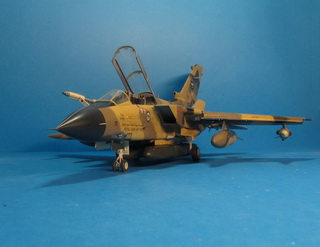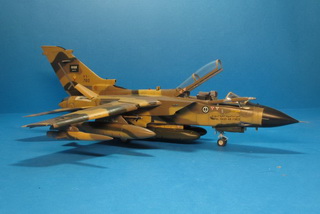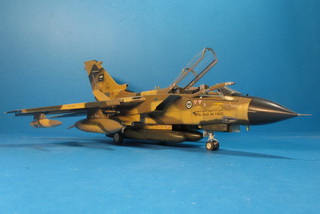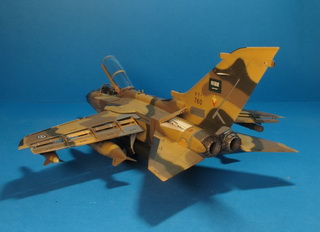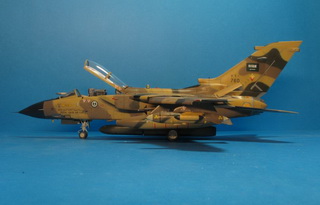Italeri 1:48 Tornado IDS 760 Saudi Arabia Air Force
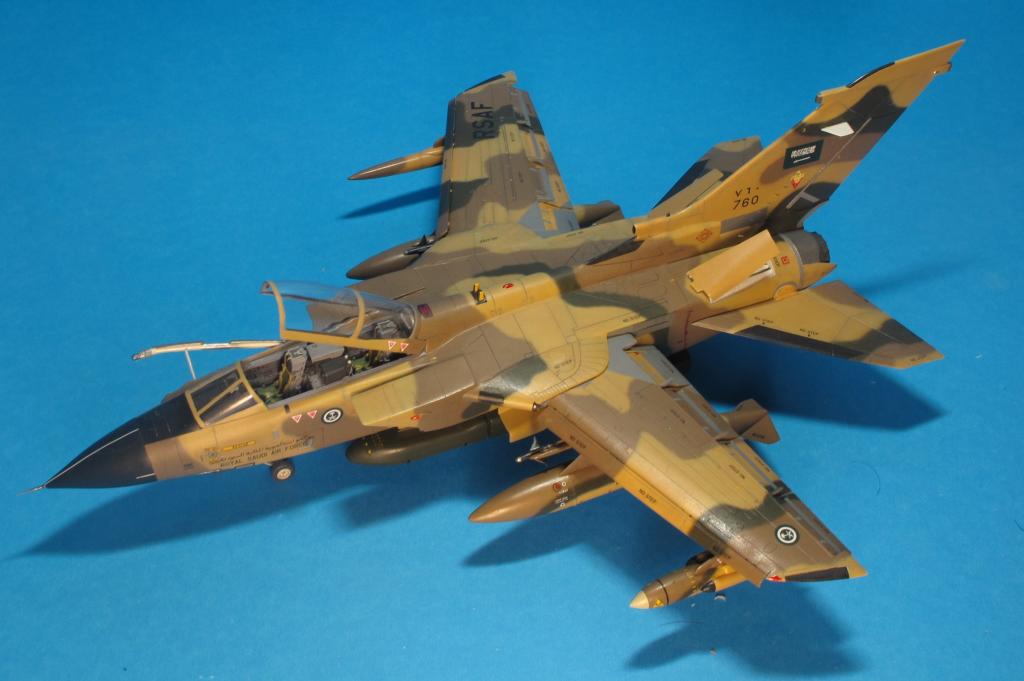 The Story
The Story
On the night of January 17th 1991, along with American and British aircraft streaming north into Iraq was the Royal Saudi Air Force.
Flying in RSAF Panavia IDS Tornado "790" was pilot Lt Col Sultan Farhan Al-Milhim and Lt. Mohammed Raja.
Earlier that night, Sultan had been at home alone when he received a phone call to return to the base.
Once there he was informed their country was going to war. Sultan and Mohammed took off with their Tornado loaded with JP233 munitions dispensers.
Their mission that night was to fly across an Iraqi airfield with other Tornados and cut the runway putting it out of service.
After take-off they climbed to the refueling track and hooked up with a RSAF tanker.
After refueling, they turned toward the Iraqi border and descended lower and lower until they set the autopilot for 200ft and turned off the navigation lights.
Crossing the border, they realized there would be no abort and they were truly in a war. The other Tornados radioed that they were low on fuel and since they could not make their time-over-target they had to abort.
This left Sultan and Mohammed as the sole Tornado attacking the airfield. At 25 miles to the target, a supporting F-4G fired a HARM at a SAM which in turn alerted the Iraqi defense of an impending strike.
Iraqi AAA fire lit up the night sky over the airfield. Intense Iraqi AAA fire caused many pilots that first night to feel fear and Sultan and Mohammed were no different from other pilots flying their first combat sortie.
Sultan thought they would surely be killed, yet they continued on with their mission. Initially, the Tornados were supposed to fly across the runway and any bombing errors would be offset by the long string of bomblets from the JP233.
Because the rest of his flight aborted and he still had to render the runway unusable, Sultan decided to fly down the length of the runway while the JP233 discharged its munitions.
For what probably seemed like an eternity, Sultan flew down a gauntlet of AAA fire and perfectly placed his munitions on target. While flying away from the airfield, the Tornado shuddered and Sultan exclaimed the aircraft had been hit.
Mohammed set him straight, telling him that was the empty JP233 dispenser being automatically jettisoned. Mohammed then calmly asked Sultan to turn for home. After crossing the border, Sultan put the Tornado into a series of rolls to celebrate their gratitude of having survived and successfully accomplished their mission.
They landed King Abdullah Aziz Air Base to a heroes welcome. After that first mission and with Sultan's advice, the RSAF stopped flying low-level missions.
The Kit
This is the fourth Italeri Tornado I have built so building this kit has become fairly routine. Aftermarket sets include: Eduard photoetch, Paragon exhausts, fin correction, bulged wheels, pylons and missile rails, slats and flaps, and the Neomega cockpit set. Aside from the resin I used, the only kit modification I did was to cut away some plastic on the refueling probe parts to make it more accurate.
For the aircraft load configuration I decided to build my Tornado loaded for a runway denial mission. I used the Airfix kit fuel tanks and JP233 dispensers. The AIM-9 missiles are from the Hasegawa weapons set. The Sky Shadow and BOZ-107 ECM pods are from Xtraparts.
Painting was done with a mixture of Model Master and Gunze Sangyo paints. Finer detail painting was done with various enamels.
To represent aircraft 760, I used decals from Model Alliance MA-48174 "Tornados at War, Desert Storm 1990-91". This sheet gave me the Royal Saudi Air Force markings and squadron crest; "760" was made from cutting a few decals for the appropriate numbers. The majority of decals represent general aircraft stencils which are from the Airfix Gr1 Tornado kit.


